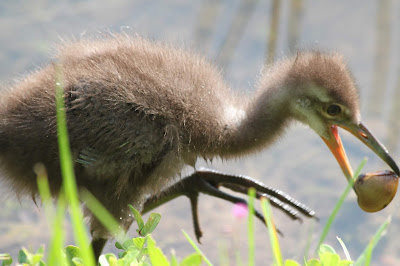Limpkins are a common bird around the ponds here in Verandah; especially the ponds bordered by woods. Sometimes I even see them perched on a tree in the woods along the pond.
Their flecked coloration allows them to blend into the woods. They look similar to a juvenile ibis. They are called limpkins because of the way they walk- it looks like they are limping. Limpkins are about the size and shape of an ibis. At one time they were hunted almost to extinction in Florida but they have made a comeback.
Limpkins love to feed on apple snails, which are abundant in the ponds. I have also seen them feed on the freshwater mussels. They are really good at grasping the snail with its slightly curved beak then pulling out the flesh inside. I've also seen them crack open freshwater mussels with their beaks. The apple snail is an invasive species. Usually native populations decline when an invasive species takes over, but in this case, the population of limpkins in Florida has steadily increased due to an abundance of its favorite food. Along the shoreline of the pond, are discarded apple snail and mussel shells, left by the feeding limpkins.
They are one of the noisiest birds here at Verandah. At dawn or dusk you can hear them crying out. They are also very noisy at night. My very good friend, Kathleen Konicek-Moran, painted this picture of a pumpkin, titled "Night Screamer of the Everglades."
A special treat was watching a pair of limpkins with their two babies. They were so cute and had their downy feathers. The parents were teaching the babies how to feed on the snails and mussels.
Their flecked coloration allows them to blend into the woods. They look similar to a juvenile ibis. They are called limpkins because of the way they walk- it looks like they are limping. Limpkins are about the size and shape of an ibis. At one time they were hunted almost to extinction in Florida but they have made a comeback.
Limpkins love to feed on apple snails, which are abundant in the ponds. I have also seen them feed on the freshwater mussels. They are really good at grasping the snail with its slightly curved beak then pulling out the flesh inside. I've also seen them crack open freshwater mussels with their beaks. The apple snail is an invasive species. Usually native populations decline when an invasive species takes over, but in this case, the population of limpkins in Florida has steadily increased due to an abundance of its favorite food. Along the shoreline of the pond, are discarded apple snail and mussel shells, left by the feeding limpkins.
They are one of the noisiest birds here at Verandah. At dawn or dusk you can hear them crying out. They are also very noisy at night. My very good friend, Kathleen Konicek-Moran, painted this picture of a pumpkin, titled "Night Screamer of the Everglades."
A special treat was watching a pair of limpkins with their two babies. They were so cute and had their downy feathers. The parents were teaching the babies how to feed on the snails and mussels.






No comments:
Post a Comment